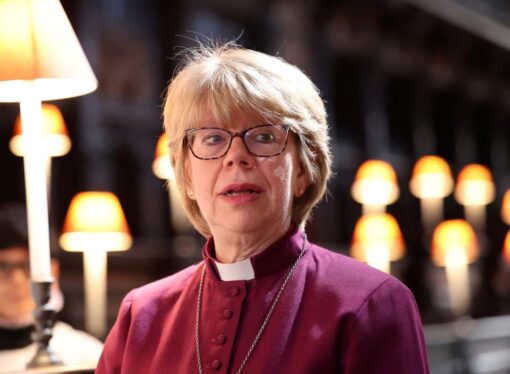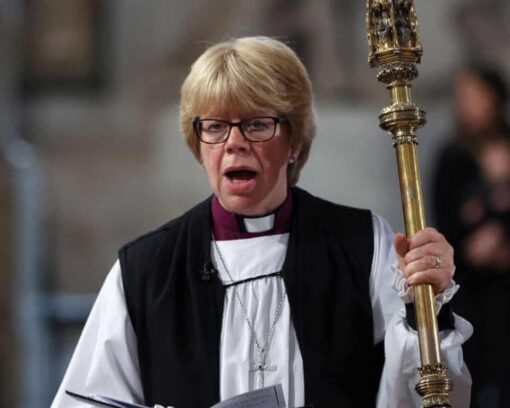The Church of England has entered a new era as Sarah Mullally was named the first female Archbishop of Canterbury, a groundbreaking appointment that signals both continuity and transformation within Anglican tradition.
Her elevation, announced on October 3, 2025, makes her the 106th Archbishop and the first woman to occupy the role since the church’s founding more than 450 years ago.
For centuries, the Archbishop of Canterbury has been seen not only as the spiritual leader of the Church of England but also as the symbolic head of the global Anglican Communion, which represents nearly 85 million members worldwide.

The appointment of the first female Archbishop of Canterbury is, therefore, more than a milestone in gender equality—it is a moment that will ripple across global Christianity.
A Landmark Appointment
Sarah Mullally’s appointment comes just over a decade after the Church of England began consecrating women as bishops in 2014.
At the time, the decision was hailed as a historic correction to centuries of exclusion, though some factions within the church resisted the change. Mullally herself was consecrated as Bishop of Crediton in 2015 and later became Bishop of London in 2018, the third most senior post in the Church of England.
Her new role as the first female Archbishop of Canterbury is widely regarded as the culmination of this gradual yet decisive shift. It also reflects a broader movement within Anglicanism to embrace diversity and adapt to changing social expectations while holding on to core traditions of faith.
Succeeding Justin Welby
Mullally succeeds Justin Welby, who served as Archbishop since 2013 and resigned earlier this year amid criticism over the church’s handling of safeguarding and abuse scandals. While Welby was praised for his commitment to reconciliation and global outreach, his tenure was marred by internal conflict over sexuality, safeguarding, and declining attendance.
In her first remarks following the announcement, Mullally emphasized healing and trust:
“The church must be a place where the vulnerable find safety, the faithful find hope, and where all are welcomed into God’s love. As the first female Archbishop of Canterbury, I accept this role with humility and with a commitment to serve faithfully.”
Her leadership will inevitably be measured against Welby’s legacy, but the very fact of her appointment signals a deliberate turn toward renewal and reform.
Who Is Sarah Mullally?
Before entering the priesthood, Mullally trained as a nurse and rose to become England’s Chief Nursing Officer, the highest-ranking nurse in the country. Known for her strong pastoral sense, administrative skill, and deep concern for justice, she brings both professional and spiritual authority to her new position.

Mullally’s career trajectory is unusual among senior church leaders. She is not only a theologian but also someone who has led large institutions and shaped public health policy. This dual background may prove invaluable as she navigates the complexities of leading a global communion that often struggles with unity across cultural and theological divides.
Global and Local Significance
The installation of the first female Archbishop of Canterbury will likely be celebrated across much of the Anglican world, particularly in regions where women already serve as bishops and primates.
However, it may also provoke resistance in more conservative provinces, particularly in Africa and parts of Asia, where opposition to women’s ordination remains strong.
Domestically, Mullally’s leadership could offer a chance to address challenges such as declining attendance, safeguarding failures, and questions about the church’s stance on LGBTQ+ inclusion. Her reputation for listening carefully to differing perspectives may help steer the Church of England through some of its most divisive debates.

Reactions to the Appointment
Reactions to Mullally’s appointment have been swift and varied. Supporters have hailed the decision as long overdue. “This is a day of great joy,” said the Reverend Lucy Winkett, Rector of St James’s, Piccadilly. “For generations, women have been faithful leaders within the church. To see Sarah Mullally named the first female Archbishop of Canterbury is a powerful affirmation of equality and justice.”
Some more traditional voices, however, have expressed concern. Critics argue that the decision could deepen rifts within the Anglican Communion and further alienate conservative congregations.
Mullally herself has acknowledged these tensions, pledging to work for unity: “Our differences should not define us, but our shared faith in Christ should.”
Looking Ahead
The formal election confirmation for Mullally will take place in January, followed by an enthronement ceremony at Canterbury Cathedral later in the year.
Both events will be rich in symbolism, with the enthronement expected to draw religious leaders, political figures, and representatives from across the Anglican Communion.
As she begins her tenure, Mullally faces daunting challenges:
Rebuilding trust after safeguarding scandals
Addressing steep declines in church attendance
Navigating debates over sexuality and doctrine
Maintaining unity across a worldwide communion
Yet her historic appointment also opens new possibilities. The symbolism of a woman holding the highest office in the Church of England may inspire a new generation of believers, especially women who for centuries were excluded from such roles.
Conclusion
The naming of Sarah Mullally as the first female Archbishop of Canterbury marks one of the most significant turning points in modern church history.
More than a symbolic victory, her appointment represents a profound shift in the life of the Church of England and the wider Anglican world.
While her path will not be without resistance or difficulty, Mullally’s combination of pastoral compassion, institutional leadership, and pioneering spirit equips her well for the task ahead. For many, her leadership embodies hope that the church can be both faithful to tradition and responsive to the world it serves.
As she prepares to take her seat in Canterbury, one thing is clear: history has been made, and the Church of England will never be the same again.
More news at here


